Explore Jeonju - South Korea Travel, Asia
Jeonju is a vibrant city located in the North Jeolla Province of South Korea. It serves as both the capital of the province and a significant cultural and historical center. Lcoated in the central part of Jeollabuk-do, Jeonju's history dates back to the Baekje Kingdom, around 57 BC, when it was founded as a market town. It gained prominence during the Later Baekje Kingdom under the leadership of Gyeon Hwon, who made it his capital, renaming it Wansan. The city's historical significance continued into the Joseon Dynasty, founded by Yi Seong-gye. The city became an important provincial capital and a center of Confucian scholarship, housing copies of the Annals of the Joseon Dynasty.
Population: approximately 666,000 as of 2024.
Economy: While Jeonju has not industrialized as rapidly as some other Korean cities, it remains an important cultural and administrative center. The local economy is supported by traditional tourism, agriculture, and a burgeoning food industry, with Jeonju being recognized as a UNESCO Creative City of Gastronomy.
Landmarks: Jeonju Hanok Village, Gyeonggijeon Shrine, Jeondong Catholic Church, Omokdae and Imokdae, Pungnam Gate, Hanbyeokdang Pavilion, National Intangible Heritage Center
South Korea
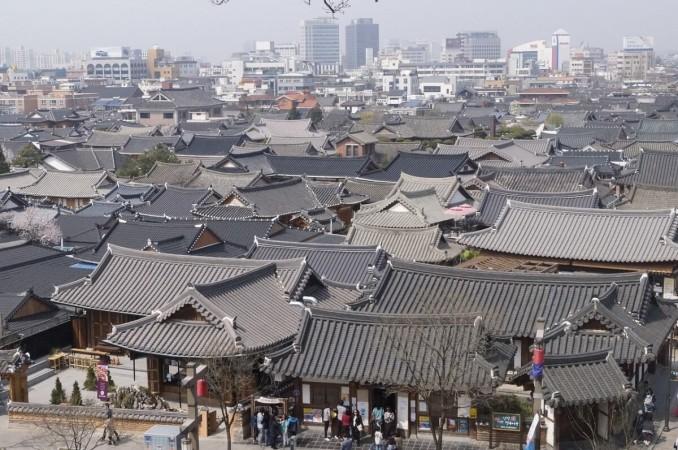
Overview of Jeonju
History & Culture Influence
Jeonju's rising during the Joseon Dynasty (1392–1897) was considered the ancestral home of the dynasty's founder, King Taejo. Jeonju played a crucial role in the dynasty's history, serving as a repository for the Annals of the Joseon Dynasty, which are still preserved in the city today. Jeonju's cultural influence extends beyond its historical sites. The city is a UNESCO Creative City of Gastronomy, celebrated for its culinary heritage, particularly its bibimbap, a mixed rice dish that has become synonymous with Korean cuisine. The city's commitment to preserving and promoting its traditional culture is evident in its numerous festivals, such as the Jeonju International Film Festival and the Jeonju International Sori Festival, which attract global audiences and showcase the city's cultural vibrancy.
Interaction with The Locals
The ethnic makeup is largely homogeneous, with Koreans making up the vast majority of the population. The people of Jeonju take great pride in their city's history and cultural significance. This is reflected in the numerous cultural festivals and events held throughout the year. Visitors to Jeonju can expect a warm and welcoming interaction with the locals.
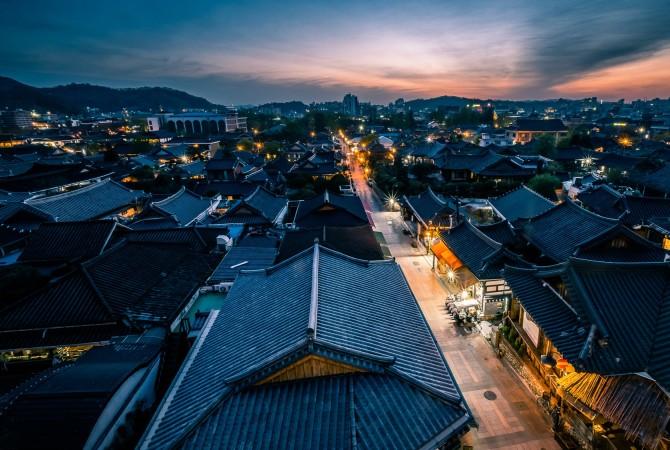
Jeonju UNESCO Creative City of Gastronomy - © Flickr (@Giuseppe Milo)
Top attractions in Jeonju
Jeonju Hanok Village
Jeonju Hanok Village is home to over 800 traditional Korean houses, or hanoks, making it one of the largest collections of these architectural treasures in the country. Visitors can wander through its charming cobblestone streets, sample local delicacies like bibimbap, and immerse themselves in cultural experiences such as wearing hanbok (traditional Korean attire) and learning about tea ceremonies. The village offers a beautiful glimpse into Korea’s rich cultural and architectural heritage.
Gyeonggijeon Shrine
Built in 1410, Gyeonggijeon Shrine enshrines the portrait of King Taejo, the founder of the Joseon Dynasty. The shrine is a serene and historically significant site, featuring traditional Korean architecture and beautifully landscaped gardens. It’s a peaceful place to reflect on the country’s royal heritage and to admire the intricate craftsmanship of the structures within the shrine complex.
Jeondong Catholic Church
Jeondong Catholic Church, completed in 1914, blends Romanesque and Gothic styles and stands as a historical landmark in Jeonju. Known for its stunning stained-glass windows and ornate design, the church is a significant symbol of the spread of Christianity in Korea. Its beauty and historical importance make it a must-visit for those interested in architecture and history.
Omokdae and Imokdae
These two historic pavilions, perched on a hill overlooking Jeonju, offer sweeping views of the city and Hanok Village. Omokdae is renowned for being the site where King Taejo celebrated his military victories, while Imokdae provides a tranquil spot to enjoy the natural surroundings. Both pavilions are ideal for those seeking a peaceful retreat with a touch of history.
Jeonju Nambu Market
Jeonju Nambu Market is a bustling hub where locals and tourists come to experience the flavors of Jeonju’s famed culinary scene. It’s the best spot to try the city’s signature bibimbap, along with a variety of other street food delights. Beyond food, the market also offers traditional crafts, fresh produce, and souvenirs, making it a must-visit for anyone looking to get a taste of local life.
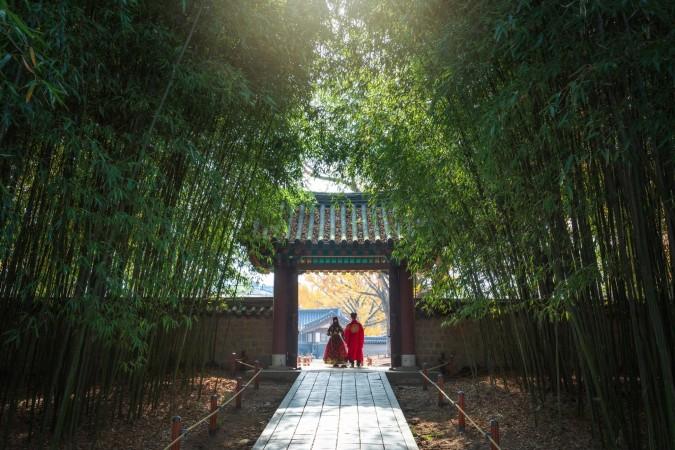
Gyeonggijeon Shrine, Jeonju - © Magical Korea
Must-Try Dishes in Jeonju
- Jeonju Bibimbap: Jeonju is the birthplace of bibimbap, a renowned Korean dish consisting of steamed rice topped with a variety of vegetables, beef, and a fried egg, all mixed with gochujang (red chili paste). Jeonju's version is particularly famous for its use of high-quality ingredients sourced from the surrounding fertile lands, making it a staple of the city's culinary identity.
- Kongnamul Gukbap (Bean Sprout Rice Soup): This dish is a comforting soup made with bean sprouts and rice, often enjoyed as a hangover cure. Known for its light and refreshing flavor, kongnamul gukbap is a popular breakfast choice in Jeonju and reflects the city's emphasis on simple, healthy ingredients.
- Makgeolli: Jeonju is also famous for its makgeolli, a traditional Korean rice wine. The city's version is known for its slightly sweet and tangy flavor, often enjoyed with savory side dishes. Makgeolli is a significant part of Jeonju's dining culture, often shared among friends and family during meals.
- Baguette Burger: A fusion dish that combines Western and Korean flavors, the baguette burger features smoked pork with a sauce made of Cheongyang red pepper, soy sauce, cabbage, garlic, onion, and mayonnaise, all assembled in a baguette. This creative dish is a popular street food in Jeonju Hanok Village.
- Grilled Cheese Skewers: A popular street food in Jeonju, these skewers feature cheese grilled to a golden color, offering a crispy exterior and a soft interior. Drizzled with yogurt sauce, grilled cheese skewers are a delicious snack for visitors exploring the Hanok Village.
- Water Parsley Dumplings: These dumplings are filled with water parsley, a local specialty, offering a unique taste of Jeonju's fresh produce. They are a vegetarian option among the city's top delicacies, showcasing Jeonju's commitment to using local ingredients in its cuisine.
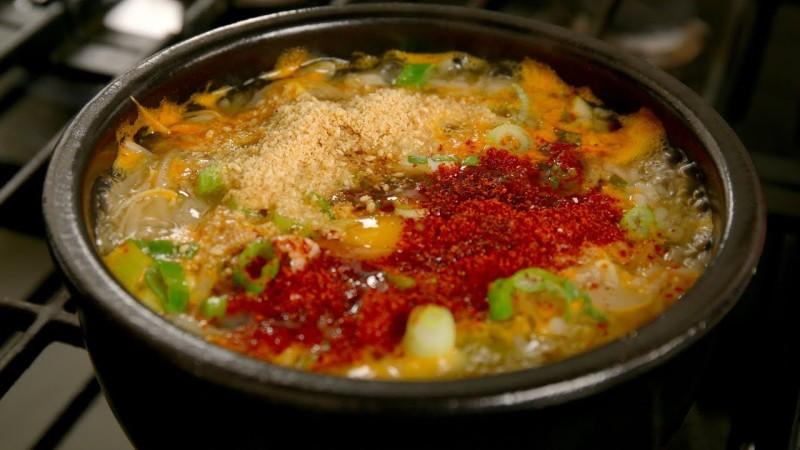
Kongnamul Gukbap (Bean Sprout Rice Soup) - © Maangchi
Festivals & Local Celebrations
- Jeonju International Film Festival: Held from May 1 to May 10, 2024, this festival is renowned for showcasing independent films from around the world. It offers a platform for filmmakers to present their work and for audiences to enjoy a diverse range of films in a vibrant cultural setting.
- Jeonju Hanji Culture Festival: Taking place from October 9 to October 13, 2024, this festival celebrates the traditional Korean paper known as hanji. The event includes a traditional hanji crafts contest and aims to promote the cultural and commercial significance of Jeonju's hanji.
- Jeonju Bibimbap Festival: Scheduled for October 3 to October 6, 2024, this festival is the largest food festival in Jeonju, attracting thousands of visitors. It celebrates Jeonju's culinary heritage, particularly its famous bibimbap, and offers a variety of cultural and entertainment activities.
- Jeonju Gaemaek Festival: From July 25 to July 27, 2024, this festival invites visitors to enjoy a refreshing beer with simple snacks, providing a relaxing atmosphere to unwind and experience local culture.
- Jeonju International Sori Festival: Held from August 14 to August 18, 2024, this prestigious music and art festival features a wide range of performances, celebrating traditional Korean music and international sounds.
- Cultural Heritage Night Tour: Scheduled for May 31 to June 1 and October 4 to October 5, 2024, this event allows visitors to explore Jeonju's cultural heritage sites at night, offering a unique perspective on the city's historical landmarks.
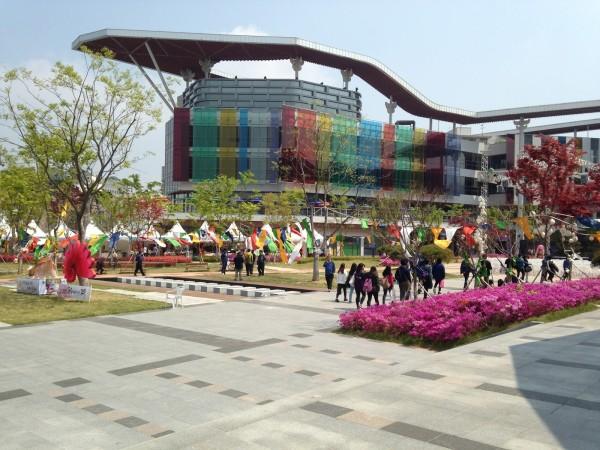
Jeonju Hanji Culture Festival - © Hanji Naty
What to Do in Jeonju
- Explore Jeonju Hanok Village: Stroll through the picturesque streets of Jeonju Hanok Village, which features over 800 traditional Korean houses (hanoks). Visitors can immerse themselves in the rich culture by trying on hanbok (traditional clothing), visiting craft workshops, and enjoying local delicacies at various eateries. The village serves as a living museum of Korean heritage.
- Visit Gyeonggijeon Shrine: Located within the Hanok Village, Gyeonggijeon Shrine is dedicated to King Taejo, the founder of the Joseon Dynasty. The shrine complex includes beautiful gardens and the Royal Portrait Museum, where visitors can learn about Korea's royal history and enjoy the serene atmosphere.
- Hike to Omodae Viewpoint: For a bit of outdoor adventure, hike to Omodae Viewpoint, which offers stunning panoramic views of Jeonju and the Hanok Village. The hike is accessible, with wooden staircases leading to the summit, making it suitable for visitors of all ages. The viewpoint is a perfect spot for photography and enjoying the scenery.
- Stroll Along the Jeonjuchun River: Enjoy a leisurely walk or bike ride along the Jeonjuchun River, where a scenic trail runs beside the water. This area is ideal for relaxation and offers beautiful views, especially during sunrise or sunset. Visitors can stop at pavilions along the way to rest and take in the natural beauty.
- Indulge in Local Cuisine: Jeonju is famous for its bibimbap, and trying this iconic dish is a must. Visitors can explore various restaurants and street vendors offering their unique takes on this mixed rice dish, which features fresh vegetables, beef, and a fried egg. Additionally, visitors can sample other local specialties, such as kongnamul gukbap (bean sprout soup) and makgeolli (rice wine).

Gyeonggijeon Shrine - © Wikimedia
Weather in Jeonju: Best Time to Visit
Average Temperatures
- Winter (December to February): Average highs range from 4°C (39°F) in January to 6°C (43°F) in December. Average lows can drop to -5°C (23°F) in January.
- Spring (March to May): Temperatures gradually rise, with averages of 12°C (54°F) in March, reaching about 23°C (73°F) in May.
- Summer (June to August): This season is warm and humid, with average highs peaking at 30°C (86°F) in August and lows around 22°C (72°F).
- Autumn (September to November): Temperatures cool down, averaging 26°C (79°F) in September and dropping to 13°C (55°F) in November.
Rainfall Patterns
- Annual Rainfall: Jeonju receives an average of about 1,997 mm (78.7 inches) of precipitation per year, with most rainfall occurring during the summer months.
- Wettest Months: July and August are the rainiest months, with average rainfall of approximately 346 mm (13.6 inches) in July and 433 mm (17 inches) in August.
- Driest Months: The driest months are typically January and February, with around 52 mm (2 inches) and 44 mm (1.7 inches) of rainfall, respectively.
Best time to visit
- Spring (April to June): Spring is widely regarded as the ideal season to visit Jeonju, with mild temperatures typically ranging from 10°C to 25°C (50°F to 77°F). This period is especially beautiful due to the blooming cherry blossoms and colorful flowers, creating a picturesque setting throughout the city. Major events, such as the Jeonju International Film Festival in May and the Hanji Culture Festival, also take place during this time, adding to the cultural allure.
- Autumn (September to November): Autumn is another favorable time to visit, with temperatures cooling down to a comfortable range of 10°C to 22°C (50°F to 72°F). The vibrant autumn foliage provides a stunning backdrop, particularly in the traditional gardens and temples. Visitors can also enjoy the Jeonju Bibimbap Festival, which celebrates the city's most famous dish, making it a highlight of the season.
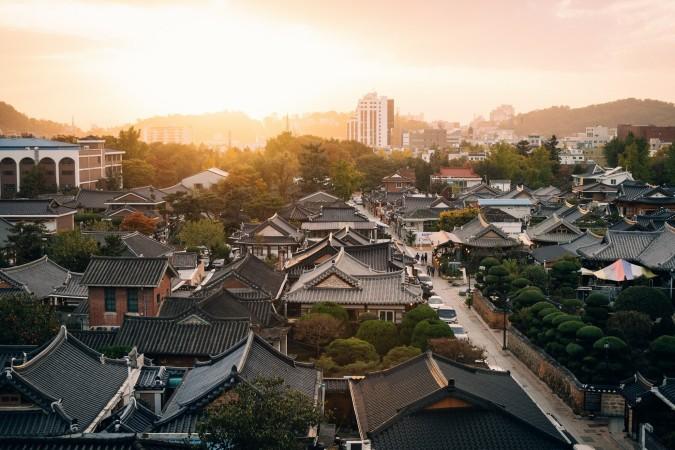
Hanok Village, Jeonju - © rawkkim
Culture Etiquette in Jeonju
General Etiquette
- Respect for Elders: In Korean culture, showing respect to elders is paramount. This involves deferring to their opinions, waiting for them to speak first, and using formal language. When greeting or interacting with older individuals, a slight bow is customary.
- Use of Hands: When giving or receiving items, such as gifts or money, always use both hands or your right hand supported by your left. This gesture shows respect and politeness.
- Shoes and Hats: Remove your shoes before entering a Korean home, as this is a common practice to maintain cleanliness. Similarly, removing hats indoors is considered polite.
Dining Etiquette
- Table Manners: Wait for the eldest person to start eating before you begin. It is customary to say "jal meok-ge-sseum-ni-da" before eating, which means "I will eat well," and "jal meo-geoss-seum-ni-da" after finishing, meaning "I ate well".
- Use of Utensils: Koreans use chopsticks and spoons for meals. Avoid sticking chopsticks upright in a bowl of rice, as this resembles a funeral rite.
- Drinking Customs: Drinking is a significant part of Korean social culture. When drinking alcohol, it is polite to turn your head away from elders and cover your mouth. Fill others' glasses before your own and wait for someone else to refill yours.
Social Interactions
- Communication Style: Koreans generally speak at a moderate volume. Speaking too loudly or slowly can be perceived as rude. Simple English is often appreciated if language barriers exist.
- Dress Code: Dressing neatly and appropriately is important in Korean culture. While casual attire is acceptable, overly revealing or sloppy clothing might be frowned upon.
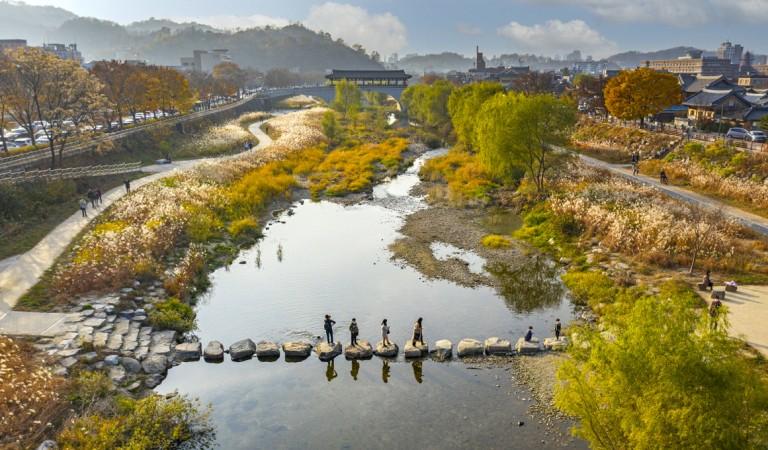
Jeonjuchun River trail - © Jeonju Tourism
Essential Travel Information
Getting Around Jeonju
- Buses: Jeonju has an extensive bus network that covers most parts of the city. Buses are the primary mode of public transportation within Jeonju, offering a cost-effective way to explore the city.
- Taxis: Taxis are widely available in Jeonju and can be a convenient way to travel, especially for short distances or when public transportation is less accessible.
ATM and Banking Services
Jeonju has numerous ATMs available throughout the city, particularly in busy areas and near popular tourist attractions. Many of these ATMs accept international credit and debit cards, making it easy for travelers to withdraw cash.
Notable ATM locations include:
- 365ATM: Located at multiple sites, including Deokjin-dong and Ua-dong, these ATMs are accessible for cash withdrawals.
- Jeonbuk Bank Cashpoint: Located in Deokjin-gu, this bank provides ATM services for both locals and tourists.
- Korea Development Bank: Another option for banking services and cash withdrawals.
Where to Stay in Jeonju
Jeonju offers a wide range of accommodation options to suit different budgets and preferences:
- Traditional Hanok Stays: For a unique experience, visitors can stay in traditional hanoks located in Jeonju Hanok Village. These accommodations provide a glimpse into Korean culture and architecture, often featuring tatami mats and ondol (heated floors).
- Hotels: Jeonju has various hotels ranging from luxury to budget-friendly options. Popular choices include: Lahan Hotel Jeonju
- Guesthouses and Hostels: For budget travelers, numerous guesthouses and hostels are available, offering shared and private rooms. These accommodations often provide a more social atmosphere and opportunities to meet other travelers.
Articles for you

Experience Aboard The RV Indochine II - A Mekong Cruise With Tweet World Travel
The RV Indochine II is a luxury river cruise ship, offering an unforgettable journey through many attractions along the Mekong River. Built in 2017, this upscale vessel combines colonial elegance with modern conveniences to create a comfortable yet stylish environment for its crew and passengers. The ship’s intimate size makes it ideal for those seeking a more personal cruising experience while exploring Vietnam and Cambodia rich culture, scenery, and heritage. Whether you're gazing at the landscape from your private balcony or enjoying authentic local cuisine, RV Indochine II promises an exotic adventure like no other.

Witness Stilt Fishing In Sri Lanka: An Eco-Tourism Experience
Sri Lanka, renowned for its stunning beaches and rich cultural heritage, harbors a unique tradition that has captivated travelers for centuries: stilt fishing. This ancient practice, passed down through generations of coastal communities, blends artistry with necessity, offering a glimpse into a way of life intimately connected to the island's coastal rhythms. Stilt fishing in Sri Lanka isn't merely a means to catch fish; it's a cultural emblem, embodying the resilience and ingenuity of Sri Lanka's fishing communities.

Make Your Trip Stress-Free With The Tweet Trip App
Embark on your next adventure with confidence by downloading the Tweet Trip App, available for both iOS and Android. This essential travel companion allows you to view your detailed itinerary, stay connected with your tour guide and fellow travelers, receive real-time updates, and provide feedback effortlessly. With features like in-app messaging, emergency assistance, and location sharing, the Tweet Trip App ensures you travel smarter, stay connected, and enjoy a seamless, worry-free journey. Get started today and make the most of your travel experience with Tweet World Travel.

Pedal Through Paradise: Unveiling Cambodia's Hidden Gems on Two Wheels
The gentle whir of bicycle wheels mingles with the distant chants of monks as you glide past emerald rice paddies stretching to the horizon. This is Cambodia - a sensory explosion waiting to be experienced on two wheels. At Tweet Tours, we believe there's no better way to immerse yourself in the Kingdom of Wonder than by bicycle.
Cambodia isn't just a destination; it's a living, breathing tapestry of ancient wonders, natural beauty, and vibrant culture. Our carefully crafted cycling tours take you beyond the typical tourist haunts, offering a unique perspective on this captivating country. Ready to clip in and discover the magic of Cambodia? Let's ride!

Trekking in the Himalayas: A Journey Through Nepal's Majestic Peaks
The Himalayas rise from the earth like colossal guardians, their snow-capped peaks piercing the sky in a display of nature's raw power and beauty. Nepal, nestled at the heart of this mountain range, serves as the gateway to some of the most breathtaking trekking experiences on the planet. Here, the air is crisp and thin, filled with the promise of adventure and the whispers of ancient tales.
With Tweet Tours, as you set foot on these hallowed trails, you're not just a traveler - you're a modern-day explorer, following in the footsteps of legendary mountaineers and age-old traders. Each step takes you further into a world where nature reigns supreme and human resilience is tested against the backdrop of some of the world's highest peaks.
From the moment your boots touch the ground in Kathmandu, you'll feel the pull of the mountains. The bustling streets of the capital, with their sensory overload of sights, sounds, and smells, soon give way to serene mountain paths where the only soundtrack is the crunch of gravel underfoot and the distant tinkling of yak bells.

Exploring Mui Ne's Wonders: Unique Attractions & Local Dishes
Nestled along the southeastern coast of Vietnam, Mui Ne emerges as a captivating gem, blending natural wonders with cultural richness. Renowned for its stunning landscapes and unique attractions, Mui Ne beckons travelers seeking both relaxation and adventure in equal measure. Mui Ne's renowned beach dunes, bustling fishing towns, and excellent local food await exploration at every turn.
The allure of Mui Ne lies not only in its pristine beaches and crystal-clear waters but also in its diverse range of activities catering to every traveler's whims. Whether you're drawn to thrilling water sports like kitesurfing and windsurfing on its dynamic shores or seeking tranquility amidst the picturesque Fairy Stream, Mui Ne promises an unforgettable journey filled with discovery.
